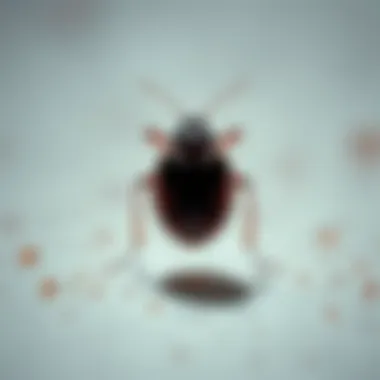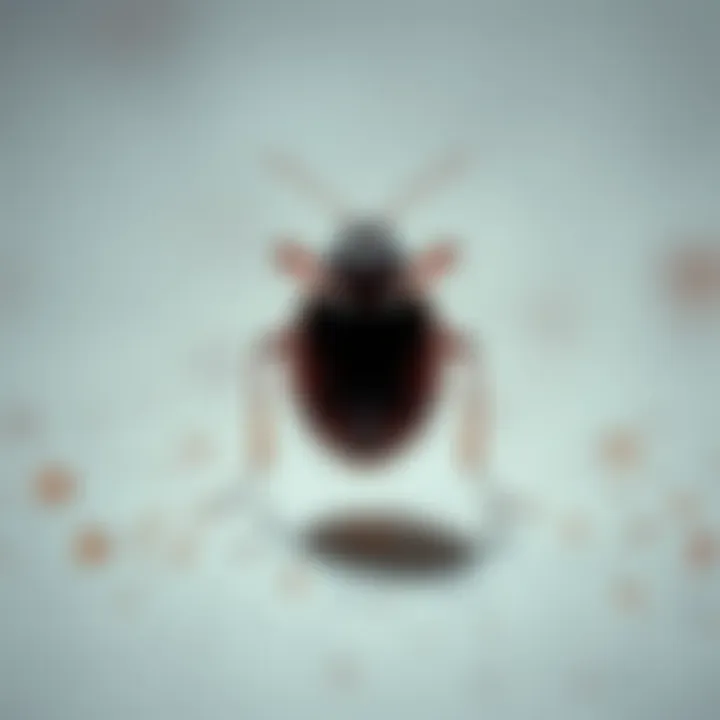In-Depth Look at Bed Bug Experiences and Solutions


Intro
Bed bugs, those sneaky little critters, have a fascinating history that stretches back thousands of years. They can turn a peaceful home into a battlefield, instilling fear and anxiety in those unfortunate enough to host them. These pests don't discriminate; they can invade plush urban apartments just as easily as cozy countryside cottages. Understanding the chronicles of bed bug infestations is crucial for anyone looking to arm themselves against these nocturnal nuisances.
The importance of recognizing bed bugs lies in the ability to identify the signs early on. The longer they linger, the more challenging it is to eradicate them. Moreover, the emotional toll that comes with a bed bug infestation can be just as significant as the physical irritation resulting from their bites. People often find themselves doubting their hygiene or feeling ashamed, which adds to the mental burden that these insects carry.
As we embark on this journey through the bed bug chronicles, we will share personal anecdotes from those who have faced these unwelcome guests. Alongside these stories, we will dive into the science behind the creatures, discussing their habits, habitat, and the impact they have on human psychology. Furthermore, we will examine effective management strategies and explore emerging pest control technologies to illustrate a comprehensive view of this pressing issue. Let's explore the complexities of bed bug experiences and the extensive knowledge available to tackle them.
Prolusion to Bed Bugs
Bed bugs are a topic not to be shrugged off lightly, especially in dwellings where peace and comfort are expected. Understanding their biology, behavior, and the imprint they leave on human history helps demystify these pesky critters. This section sets the stage for comprehending the depth of infestation issues and the significant emotional and practical fallout that can accompany these experiences.
Understanding Bed Bug Biology
Physical Characteristics
The first step in tackling any pest issue is knowing what you're up against. Bed bugs are small, usually brownish with an oval shape and generally about the size of an apple seed. Their flat bodies allow for easy hiding in seams, cracks, and crevices.
One notable trait is their ability to change color after feeding; they can shift to a reddish hue, a characteristic that can be quite alarming for those first encountering them. This unique physicality not only aids in their survival but makes them a tough adversary in eradication efforts. The more you know about these characteristics, the more effectively one might combat them.
Life Cycle
Understanding the life cycle of bed bugs is crucial for grasping how quickly infestations can escalate. They go through five stages of growth before reaching adulthood. Each stage requires a blood meal to develop, which contributes to their proliferation.
A significant feature of their life cycle is their resilience; under favorable conditions, a few can quickly become hundreds in just a few months. This rapid reproduction makes timely detection of their presence paramount. Knowing this can help individuals take preventive actions at early signs of infestations, saving time and money in the long run.
Feeding Habits
When it comes to feeding habits, bed bugs are primarily nocturnal. They tend to feast on humans while they sleep, feeding for about 10 minutes before retreating to their hiding spots. Interestingly, they can survive for months without a meal, which adds another layer of difficulty in managing these pests.
The importance of their feeding habits lies in their reliance on warmth and carbon dioxide emitted by humans to locate their host. This detail can help in devising strategies to limit their access and ultimately manage infestations.
The Historical Presence of Bed Bugs
Ancient Times
Bed bugs have been around for thousands of years, with historical texts dating back to ancient Egypt where they were considered a nuisance. Their existence in ancient times highlights not just their adaptability but also the ongoing struggle humanity has faced with these pests.
By examining ancient references, one can see that solutions varied from country to country – showing that the desperation to manage them isn’t a modern concern but rather a longstanding battle.
Modern Resurgence
Fast forward to the late 20th century, and bed bugs made a dramatic comeback. Following the widespread use of pesticides and changes in travel habits, bed bug populations have surged in urban environments. This resurgence is largely due to global travel and resistant strains of these pests developing over time.
Understanding this modern context helps highlight the importance of contemporary pest control measures and why traditional methods alone may not suffice.
Cultural References
Bed bugs have not only influenced the realm of pest control but have found their way into various cultural references—from literature to film and even music. These cultural footprints serve as a reminder of how deep-seated the fear of these pests runs in societal consciousness. They also contribute to ongoing discussions surrounding hygiene, discomfort, and societal perceptions.
By exploring these narratives, readers gain insight into the broader implications of infestations, beyond just the physical presence of these pests. It enriches the conversation about the emotional and psychological ramifications that arise from having bed bugs in your home.
Personal Stories of Infestation
Personal narratives about bed bug encounters hold immense significance in understanding the ramifications of infestations. The stories brought forth by individuals dealing with these pests provide a lens through which to view the broader implications for homeowners and society at large. Each tale not only illuminates the challenges faced but also serves as a crucial learning tool for others who may walk a similar path.
These accounts are valuable as they reveal the emotional, psychological, and financial strains that come with dealing with bed bugs. They showcase resilience, highlight mistakes made during the process, and often offer practical advice that can mitigate future issues. Recognizing the human element in these experiences makes the topic much more relatable and urges discussions on prevention and control strategies.
Anecdotes from the Front Lines
Homeowners' Experiences
Homeowners' experiences with bed bugs reveal the harsh realities of infestations. Often, these individuals recount discovering those pesky critters after feeling an unexplainable itch during the night or spotting an unusually earnest bite on the skin. The journey typically begins with disbelief, often leading to quickly turning the home upside down.
One key aspect of these stories is the sheer helplessness often expressed. Homeowners, who have invested time and money into creating their ideal living environment, suddenly face the shock of having to deal with such unwelcome guests. This makes their experiences a beneficial inclusion for the article, shedding light on how quickly the comfort of home can be upended.


A unique feature of homeowners’ tales is the chaos that comes with the diagnosis. From washing all clothes in hot water to tossing furniture out the window, their stories often include a myriad of strategies, some successful and others not so much. This array of personal methodologies provides insights on what may work and what may fail, providing relatable content for readers.
Hotel Stays Gone Wrong
Hotel stays gone awry due to bed bugs are stories many can relate to, especially frequent travelers. Picture this: someone settling into a hotel room after a long day of travel only to find small brown spots on the sheets, the realization dawns—bed bugs!
The hallmark of these experiences is often the sudden realization and subsequent panic that ensues. Such encounters underscore the critical nature of regulated pest control within hotels, making this topic engaging for readers. People travel for leisure or business, which makes this an important cautionary tale.
What makes hotel experiences stand out is the often fleeting nature of resolution. Guests may not be able to control their environment, relying instead on hotel management's response. It's a notable disadvantage, as not everyone is well-informed regarding their rights as consumers in these situations. This uncertainty and the aftermath of potential bites often stick with them long after their stay.
Travel Tales and Cautionary Advice
Travel narratives about dealing with bed bugs span a wide range of experiences, offering cautionary tales that are vital for those who are on-the-go. Travelers often share preemptive steps, such as inspecting hotel rooms upon arrival or keeping luggage off the floor, all aimed at avoiding the unsettling encounter of taking bed bugs home.
The beauty of these stories lies in their instructive nature. Readers gain knowledge not just from what went wrong but from the tactics travelers implemented to mitigate risks. This aspect makes such narratives essential to the overall goal of the article, as it educates others on how to avoid these pests while traveling.
However, there can be a disadvantage as well; some tales point out that not all travelers are aware of these precautions. This highlights the need for increased community awareness about bed bug prevention—not only while at home but also away.
The Emotional Toll of Infestation
Anxiety and Stress
The emotional challenge presented by a bed bug infestation cannot be understated. Homeowners frequently express feelings of anxiety and stress, fearing the unknown and the disruption to their daily lives. An infestation isn't merely about eradicating pests; it often includes psychological struggles that permeate through daily routines.
This overwhelming anxiety often stems from several sources, such as the fear of social scrutiny or the financial burden associated with extermination services. Understanding this facet of pest control narratives enriches the article's context and helps demystify the various dimensions of dealing with bed bugs.
One unique feature of emotional turmoil caused by bed bugs is the notion of shared experiences. Many find solace in joining forums or community groups to discuss their battles, illustrating both the personal and collective struggle against infestations.
Social Stigmas Associated with Infestations
The social stigmas tied to bed bug infestations can further complicate matters for affected individuals. The prevailing belief that bed bugs only plague dirty homes often leads to increased shame for those grappling with an infestation. This aspect is important to highlight, as it can deter people from seeking help.
This stigma is pervasive, as many people might hesitate to share their encounters or even discuss the issue openly with friends, resulting in feelings of isolation. Challenging these social norms will resonate deeply with readers, opening a dialogue about reality rather than myths surrounding infestations.
The unique characteristic of social stigma is its potential impact on mental health. Those suffering through an infestation not only deal with the physical aspects but may also face repercussions in their social circles, affecting friendships or relationships.
Long-Term Psychological Impact
While a bed bug infestation can feel like a temporary inconvenience, the long-term psychological impacts are often profound. Many individuals report lingering stress, anxiety, or even phobias that persist long after the actual infestation is addressed. This consideration makes it a crucial piece in the overarching topic.
The key characteristic that stands out is the risk of developing a heightened sense of awareness towards one's living space. Individuals may become hyper-vigilant, constantly checking for signs of pests long after peace is restored. This chronic state of alertness can significantly affect mental wellness.
The unique feature of this aspect is the long-lasting effects that contribute to an individual's overall quality of life. Many homeowners express a hesitance to travel or invite guests over, fearing judgment or potential reinfestation. Sharing these insights empowers others to recognize that bed bugs are not just a pest problem; they are a psychological battle as well.
Identifying Infestations
Identifying infestations is the first step in combating the persistent problem of bed bugs. Ignoring signs of their presence can lead to a situation that spirals out of control, causing havoc not only in one's living space but also in one's peace of mind. Understanding the signs and common misconceptions helps empower individuals and families to act swiftly and effectively. This segment sheds light on how to recognize these unwelcome guests, providing clear signs and debunking myths, all while prioritizing practical approaches to addressing this pressing issue.
Signs of Bed Bug Presence
Bites and Skin Reactions
One of the most noticeable indicators of a bed bug presence is the telltale bites on the skin. Bed bug bites typically appear as small, red, itchy welts, and can form clusters or patterns. A key characteristic is their similarity to mosquito bites but often leads to misinterpretation. These bites tend to become inflamed over time, causing irritation, and in some cases, allergic reactions.
Detecting these bites early can significantly contribute to a timely response in managing an infestation. Understanding that these visible signs are often the result of nocturnal feeding habits allows homeowners and renters to remain vigilant. However, depending on the individual's sensitivity, some people may not react at all to bites, making it a poor standalone indicator.
Visual Cues in the Home
Another effective way to identify an infestation is through visual cues around the home. Physical evidence such as shed exoskeletons, tiny fecal stains, or actual bed bugs lurking in seams of mattresses or under furniture can serve as vital indicators. Homeowners should thoroughly inspect their living spaces for these hints.
One unique feature of visual identification is that bed bugs are often most active when one is asleep, making the nighttime inspection a critical preventive measure. This aspect leads to a sense of urgency. If left undetected, an infestation can spread like wildfire through nearby rooms and homes. It’s crucial to familiarize oneself with what to look for to take action before it gets out of hand.
Utilizing Detection Tools
In today’s tech-savvy world, various detection tools have emerged to aid in identifying bed bug infestations efficiently. Utilizing devices such as bed bug interceptors or monitoring traps can offer proactive insights into whether these pests are present. Unlike relying solely on visual checks or bites, these tools can unearth hidden bed bugs that might otherwise go unnoticed.


Notably, these detection methods can be both advantageous and limiting. They offer a non-invasive means of understanding presence and severity, yet their effectiveness hinges upon proper placement and regular monitoring. Homeowners can adapt these tools to fit their schedule and often find peace of mind knowing they have an added layer of protection against these persistent pests.
Common Misconceptions
Myths about Transmission
Inaccurate beliefs about how bed bugs spread can exacerbate public fear and stigmatization. A common myth is that bed bugs are associated with cleanliness, leading people to mistakenly suggest that dirty homes are the only ones susceptible to these infestations. This oversimplification can be dangerous, as bed bugs thrive in various environments, regardless of overall cleanliness. Understanding that bed bugs hitch rides on clothing or luggage can decrease the anxiety around cleanliness and shift the focus to prevention.
One particular unique characteristic of this myth is how it fuels unnecessary shame among those affected. Realizing that everyone is at risk can foster a more supportive community response to infestations, rather than isolating those who face these challenges.
Misunderstanding Their Habits
There is also notable confusion surrounding bed bug habits and ideal living conditions. Contrary to popular belief, these pests do not live exclusively in beds or mattresses but can find refuge in many nooks and corners of any space. Recognizing their capacity to thrive in diverse environments can help homeowners take preventative actions more seriously.
The ongoing misunderstanding of the areas they inhabit should not deter action but rather encourage a more thorough inspection of one's home to combat potential infestations. The clear danger lies in leading people to overlook potential hiding spots that may cause an infestation to magnify unnoticed until it becomes a larger problem.
"Awareness of the signs and common misconceptions about bed bugs can transform how individuals approach their living spaces and manage the risks involved."
Proper identification, understanding signs, and knowing the common myths surrounding bed bugs will form the backbone of effective management strategies against bed bug infestations. By engaging with reliable resources and communities, homeowners can protect their domains and reclaim the comfort and peace once enjoyed.
Management Strategies for Bed Bugs
When it comes to dealing with bed bugs, having a solid strategy in place is as crucial as a good map in uncharted territory. These pests can swiftly turn a serene home into a sleepless nightmare, affecting the well-being of occupants. Management strategies are not just about getting rid of these critters; they focus on understanding their habits, preventing further infestations, and employing effective control measures to manage any existing problems. Establishing a comprehensive plan enables homeowners to tackle bed bug issues proactively, rather than reactively, which is often a losing battle.
Traditional Pest Control Methods
Insecticides
Insecticides represent one of the oldest forms of pest control, and for good reason. They’re widely accessible and, when used correctly, can be incredibly effective. The hallmark of insecticides is their ability to directly eliminate bed bugs at various life stages. These chemical solutions work by disrupting the bug's nervous system, ultimately leading to their demise. However, it’s important to note that some bed bugs have developed resistance to certain insecticides, making it essential to choose the right product and method.
The main advantage of insecticides lies in their immediate impact. For households facing rapid infestations, these products can be a surefire way to see quick results. Nonetheless, not all insecticides are created equal; caution must be observed regarding their safety for children and pets. Over-reliance can also lead to resistance, like a stubborn teenager refusing to listen, complicating future eradication efforts.
Heat Treatments
Heat treatments offer a modern twist to the fight against bed bugs, leveraging temperature to eliminate entire populations. Raising the temperature in infested areas to a scorching 120°F can be lethal to bed bugs, making this method particularly effective. This approach is beneficial for a number of reasons: it can reach into crevices and pores where insects hide, effectively eliminating them without the need for chemicals. Heat treatments are also eco-friendlier, appealing to those concerned about chemical exposure.
However, the process requires specialized equipment and should ideally be handled by professionals who know their way around the proverbial kitchen. One downside is that heat treatments may not be feasible for every situation—they can be expensive and not suitable for all items in your home, particularly sensitive electronics.
Cold Treatments
Cold treatments rely on below-freezing temperatures to combat bed bug infestations. By exposing these pests to extreme cold, typically around -10°F for several days, homeowners can effectively kill all life stages of bed bugs. This method is less conventional, but it certainly packs a punch and serves as a unique weapon in the battle.
One of the biggest appeals of cold treatments is their ability to protect items that cannot withstand heat. For example, clothing or bedding can be safely placed in a freezer, effectively cleaning your belongings while ensuring that the bugs are eliminated. However, it’s important to factor in the time involved. Unlike applications of insecticides or heat, cold treatments can take days to be fully effective, requiring patience and persistence.
Innovative Approaches
Integrated Pest Management
Integrated Pest Management, or IPM for short, represents a holistic approach to pest control, combining various tactics to achieve optimal results. This method leans heavily on prevention—seeking to curtail bed bugs before they become a full-blown infestation. Homeowners using IPM benefit from not only understanding the behavior and habitat of bed bugs but also from combining chemical and non-chemical methods for maximum effectiveness.
What makes IPM stand out is its emphasis on cooperation, often requiring collaboration between homeowners and pest control professionals to optimize strategies. This method typically involves monitoring and understanding the pest's behavior and focusing on long-term solutions rather than short-term fixes.
Biological Control Solutions
Biological control solutions bring a distinctive approach to bed bug management by using natural predators to control pest populations. For example, certain types of beetles or parasitoids can be deployed to combat bed bugs effectively. The key characteristic of these biological agents is they target bed bugs without the negative consequences associated with chemical treatments.
These solutions align with sustainable practices, as they can fit well into the ecosystem without causing environmental harm. One downside, however, is that they often take longer to yield results compared to chemical solutions, requiring understanding and time from the homeowner.
Digital Monitoring Systems
Digital monitoring systems represent the cutting edge of pest control technology. These systems offer real-time data on bed bug activity, allowing homeowners to be proactive rather than reactive. By placing traps that alert users when bugs are detected, homeowners can take immediate action rather than waiting for infestations to escalate.
The primary advantage is the ease of use—monitoring can be done via mobile applications, making it user-friendly and accessible. However, they do not eliminate bugs directly; rather, they require a complementary strategy involving either traditional or innovative treatments to effectively tackle an infestation.
Preventative Measures


Preventing bed bug infestations is not just a matter of keeping a clean home; it encompasses vigilance, awareness, and community involvement. Understanding the importance of preventative measures can significantly reduce the likelihood of these pests making an unwelcome appearance. The benefits of proactively addressing potential vulnerabilities include peace of mind and an improved living environment. Avoiding the hassle and emotional strain brought on by a bed bug encounter certainly makes prevention a wise investment.
Home Maintenance Tips
Regular Cleaning Practices
Regular cleaning practices stand as a cornerstone of bed bug prevention efforts. When homes are frequently cleaned, hiding spots for bed bugs are limited. Bedding, fabrics, and furniture should be washed regularly, with particular attention given to seams and folds where these pests may reside. The key characteristic of regular cleaning is its proactive stance. By routinely tidying up, you create an environment less conducive to infestation.
The unique feature of this approach is its simplicity: it can be incorporated into existing cleaning routines without requiring extensive additional effort. One can say that regular cleaning represents a foundational habit — one that can pay dividends in the form of fewer pest problems down the line. However, it is not a standalone solution and should be applied in conjunction with other tactics.
Travel Precautions
Travel precautions play a vital role in avoiding bed bug transfers from hotels or other accommodations back to your home. When staying at a hotel, being vigilant includes checking the bedding and furniture before settling in, and keeping luggage off the floor. This practice helps prevent unwelcome hitchhikers from entering your home.
The primary characteristic of travel precautions is their adaptability; they can be tailored to individual travel habits. This flexibility makes it a popular choice among frequent travelers. A unique aspect of these precautions is that they also foster security in unfamiliar environments, allowing one to enjoy a holiday with fewer worries. However, it does require extra effort and attention during travel, which may not always be feasible.
Sealing Entry Points
Sealing entry points is another essential measure. This involves inspecting your home for cracks, gaps, or other openings that may provide entry for bed bugs. Properly caulking windows and doors, repairing screens, and replacing weather stripping can make a significant difference in pest control efforts. The main characteristic of sealing entry points is its permanency — once sealed, these measures typically last for a considerable time, providing ongoing protection against potential infestations.
The unique advantage of this method is that it not only helps in preventing bed bugs but also enhances energy efficiency by minimizing drafts. On the downside, this method may require an upfront investment in time and material, but when weighed against the potential costs of dealing with an infestation, it stands as a prudent choice.
Community Awareness and Education
In combating bed bugs, community awareness and education are pivotal. They offer a collective approach to managing and preventing the spread of infestations. These efforts ensure that everyone is informed about the risks and responsibilities associated with bed bug prevention.
Workshops and Outreach Programs
Workshops and outreach programs serve as a means to educate the public about bed bug identification and prevention. By providing hands-on training and resources, these programs empower individuals to take control of their environments. The key characteristic of these initiatives is their interactive nature, allowing participants to learn not just facts but practical applications that can be employed in real-life scenarios.
Their unique feature lies in fostering community togetherness; when neighbors work together, they create a network of vigilance that can effectively reduce the likelihood of infestations. However, participation may vary, and not all community members may be equally engaged, which could weaken overall effectiveness.
Collaborative Efforts with Pest Control Professionals
Collaborative efforts with pest control professionals form a robust strategy in the fight against bed bugs. When communities partner with experts, the level of information and resources available increases exponentially, leading to a more informed public. The primary advantage of these collaborations is the combination of local knowledge and professional expertise, creating a comprehensive approach to pest management.
The unique aspect of these collaborations is the tailored approach that can be developed, ensuring that methods are effective for the specific needs of the community. Nonetheless, these initiatives may require funding and sustained commitment from local authorities or organizations, sometimes posing a challenge to their longevity and impact.
The End
In the realm of pest control, the significance of understanding bed bug encounters cannot be overstated. This article sought to encapsulate the myriad experiences associated with infestations, shedding light on both the personal accounts and scientific insights that intertwine in this issue. Bed bugs, quite unlike other pests, carry an emotional weight that extends beyond mere annoyance; they create lasting impacts on emotional well-being and safety perceptions.
Reflecting on Bed Bug Encounters
Lessons Learned
The stories of those who have faced bed bug infestations reveal essential lessons that resonate throughout the pest control community. Homeowners often reflect on how a single experience can shift their perception of cleanliness and vigilance. Not everyone is aware that a high level of preparedness can mean the difference between a minor inconvenience and a full-blown infestation. The key characteristic of these lessons is their transformative nature; they inspire proactive measures in the face of potential threats.
One unique feature of recalling these lessons is how they foster a community of shared experiences, making it easier for individuals to navigate their setbacks. The advantages of emphasizing lessons learned include enhancing awareness and better equipping others to handle similar situations. However, the downside lies in the vulnerability such discussions can expose—people may feel discouraged rather than empowered.
The Importance of Preparedness
Preparedness forms the backbone of a proactive approach toward pest management. It emphasizes the necessity of establishing routines for home inspections and maintaining clean environments. Those who are prepared often find themselves less stressed and more in control when faced with encounters that are less than desirable. This aspect is pivotal for those affected by bed bugs, ensuring they can act quickly and effectively.
A notable characteristic of preparedness is the comprehensive toolkit it provides, spanning from learning the signs of infestation to understanding when to call a professional. This toolkit can likewise prevent the psychological burden of uncertainty that many face. Its unique feature is its adaptability; preparedness strategies can be modified based on individual needs and home environments. However, the challenge here is ensuring consistent application over time since habits can become lax.
Future Directions in Pest Control
Research Frontiers
Delving into the frontiers of research reveals promising developments aimed at mitigating bed bug populations. Modern studies often focus on understanding genetic resistance to pesticides and the efficacy of new control methods. Such cutting-edge research is important as it offers hope for more sustainable solutions.
A key characteristic of these research endeavors is their focus on integrative methodologies, which combine biological, chemical, and environmental approaches. This multifaceted exploration aims to unravel the complexities of bed bug behavior. One of the unique features of these research avenues is their collaborative nature, drawing on the expertise from various scientific backgrounds. While promising, the disadvantages may include the slow pace of research outcomes translating into practical applications.
Advancements in Sustainable Practices
The movement toward sustainable pest control has gained momentum, encouraging the development of eco-friendly methods that can effectively address bed bug outbreaks. Strategies such as utilizing natural predators or essential oils are being explored more widely. This creates a shift in the conversation around pest control, from merely eliminating the pests to establishing a more balanced ecosystem.
A significant characteristic of these advancements is their emphasis on long-term harmony and safety, both for the environment and for households dealing with infestations. The unique advantage of this approach lies in its potential to create residual benefits for communities, promoting holistic pest management practices. However, one disadvantage might be the variability in effectiveness when compared to traditional methods, raising questions about consistency and reliability.
In summary, the exploration of bed bug chronicles offers not just an understanding of personal battles, but also provides a framework for better preparedness and innovative solutions. Balancing emotional narratives with scientific research underscores the complexity of pest management and highlights the need for continued vigilance and discovery in this ongoing struggle.



